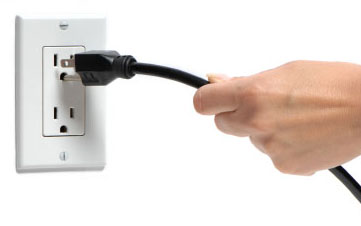Don’t forget to pull the plug and turn out the lights! While the concept is known by different names – phantom load, vampire power, standby mode – at the end of the day, “phantom energy” does the same thing: it pulls unnecessary extra energy from the grid into commercial buildings when you aren’t looking.
Many devices and gadgets, including computers, LCD monitors, copiers, printers, TVs, coffeemakers and vending machines, and central air fans, draw power even when they’re switched off or not in use … just by being plugged in. And though it may seem insignificant, this definitely adds up over time.
In an office building, for example, up to five percent of energy use comes from powering electronics that aren’t actually being utilized. These devices can use less than 5 watts to just shy of 100 watts; the older they are, the more electricity they use.
 Until recently, reducing plug loads to improve a building’s overall energy efficiency has been an overlooked strategy. However, as this type of energy consumption continues to increase, many high-rise facilities need to take a closer look at how to hold down overall consumption.
Until recently, reducing plug loads to improve a building’s overall energy efficiency has been an overlooked strategy. However, as this type of energy consumption continues to increase, many high-rise facilities need to take a closer look at how to hold down overall consumption.
While some plug load solutions function automatically when implemented, others require the implementation of a corporate-wide culture initiative, encouraging tenants and occupants to participate in programs that encourage education, awareness, motivation, and incentives. For instance, some building management teams run monthly programs that offer prizes to groups that consume the least amount of energy in a given timeframe – further proof that buy-in indeed helps ease the burden.
As the concept of powering down becomes increasingly important, the need for greater and improved technology solutions is rising. These solutions help tenants, occupants, and building managers work together to drive cost reductions, reduce energy consumption, and integrate regular environmental practices.
With the growing popularity of ratings systems to quantify energy use in buildings, the ability to effectively measure and minimize phantom energy has become important. Some newer technologies available on the market today provide the management tools and support necessary to achieve a level of energy reduction that is quite measurable and significant.
For example, one new way of controlling electricity features an easy-to-use “green box” that can be plugged into any power-consuming devices, from coffeemakers and freezers to office laser printers and copiers. Combined with software and an Internet connection, this solution can help users control power consumption to all connected devices. The information generated can be analyzed daily, providing insight about power consumption and estimated savings. These solutions can easily create schedules for ON and OFF periods, provide instant feedback reports, and help facilities professionals make effective decisions about energy use.
Although monitoring does not directly save energy, it plays two very important roles in saving energy. First in providing data to help users to understand where, when and how much energy is being used. Second, providing direct feedback to individual users on energy consumption tends to have the effect of encouraging them to reduce their energy consumption. You can’t manage what you can’t measure.
As high-rise facilities focus more and more on energy savings, it appears that providing simple, easy-to-understand feedback to users about individual energy use affects behavior and improves energy savings. Studies show that, as they become more aware of their personal energy use and how their actions affect it, users tend to modify their behavior to use energy more efficiently.
Energy efficiency is one of the most cost-effective means of reducing environmental impact. Not only does it ease the strain of limited power supply, but it helps reduce greenhouse gas levels. It creates a win-win situation by bringing cost savings and return on investment (ROI) to building owners, tenants, and occupants focused on reducing phantom energy use.
Taking advantage of these constantly improving technologies will become critical to unlocking the potential savings that be achieved in energy use around the world in years to come.
Ben Wilde
Ben Wilde is Director, Europe for FirstCarbon Solutions (FCS). He has 10 years’ experience in data management and business process outsourcing, working with numerous UK public and private-sector organizations to develop data capture and management systems. Wilde works with clients worldwide to develop outsourcing and technology services that make their energy and sustainability strategies more efficient. He is a qualified Carbon Verifier for Projects & Inventories against ISO 14065. With a BSc. in Business & Economics from the University of East Anglia, Ben also has experience leading the commercialization of more than a dozen clean tech and biotech projects via a $3 million innovation fund he cofounded for early-stage ventures. For more information, visit www.firstcarbonsolutions.com.

